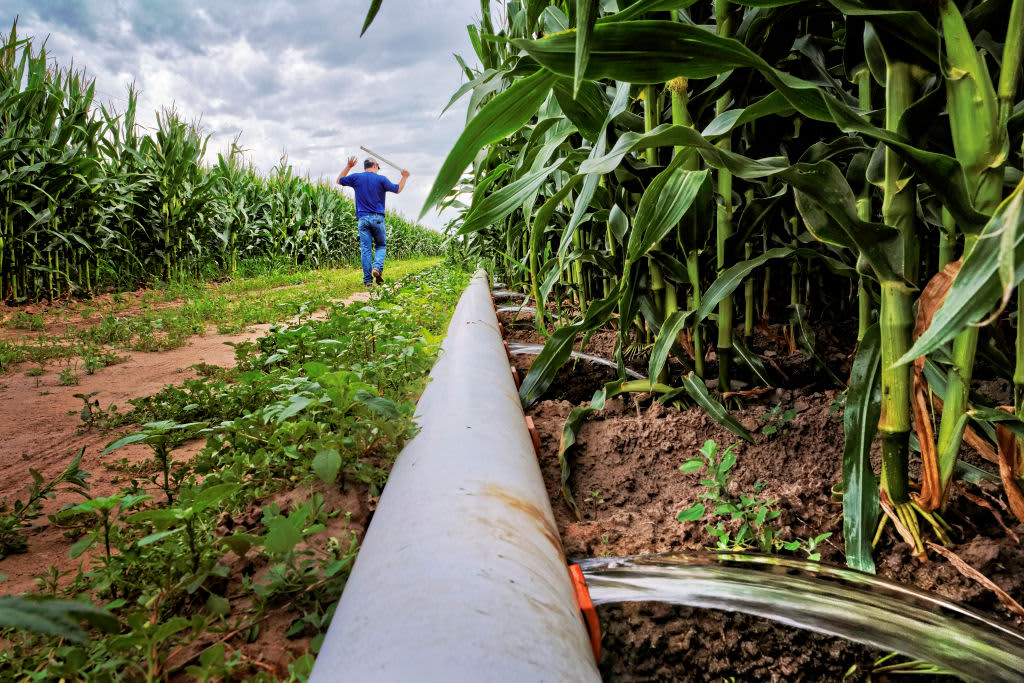
Wherever you stand on the issue of climate change, chances are you are already paying for it.
Take the cost of homeowners insurance, up 27% nationwide since 2021, according to data compiled by online insurance marketplace Insurify. And in some states, it’s far worse, like Louisiana, where premiums are projected to rise 23% this year alone.
“The insurance companies are responding to the fact that we’re seeing more frequent and more severe climate events and the fact that they’re paying out more than they’re bringing in,” said Jeremy Porter, head of climate implications for First Street Foundation, a nonprofit, nonpartisan research firm.
Hardening roads, bridges and other structures so they can withstand the climate is a major part of the $550 billion of new spending in the Bipartisan Infrastructure Law, and it will likely be an even bigger part of future measures, said U.S. Transportation Secretary Pete Buttigieg.
“We’re finding huge demand for that,” he told CNBC in June. “Putting a road on higher ground instead of rebuilding it as is every year it gets washed out, making sure that we have seismic retrofits for some of our most important bridges, things like that.”
“Resilience is something that no one, no matter where they stand, is going to be against, because it’s what they do in their own personal lives when they have to make a decision on a car or a decision about a house,” said Maria Lehman, director of U.S. infrastructure for global engineering firm GHD, and 2023 president of the American Society of Civil Engineers. “There is a fiscal cost over the asset if you don’t do it right.”
That is why companies are paying increasingly close attention to climate risk, resilience, and sustainability when deciding where to locate, and it is why CNBC factors them into the all-important Infrastructure category in this year’s America’s Top States for Business study. Under this year’s methodology, Infrastructure is the heaviest weighted category, accounting for 17% of a state’s overall ranking.
We looked at factors including state-level figures provided by First Street for properties at risk of major damage from flooding, extreme heat, wildfires and wind in the next 30 years.
We also considered National Oceanic and Atmospheric Administration (NOAA) data on extreme weather for the primary geographic regions within which the U.S. states are situated, and U.S. Department of Energy data on renewable power.
Some states are particularly vulnerable to climate risks, but these ten states are most ready for what Mother Nature has in store.
10. Oregon
Solar collector field, Christmas Valley, Oregon.
Marli Miller | UCG | Universal Images Group | Getty Images
The Beaver State is no stranger to climate issues, including sometimes intense winter storms, wildfires, and more. But the state is reasonably well equipped to handle them. Oregon is already a leader in renewable energy, getting more than two-thirds of its power from renewable sources, according to the U.S. Department of Energy. Now, with funding from the federal infrastructure law and a mandate from the state legislature, the Oregon Department of Energy is developing a comprehensive strategy this year to harden its energy systems.
2024 Infrastructure Score: 242 out of 425 points (Top States Grade: B+)
Climate Extremes Index (National Average: 32.92%): 16.54%
Properties at risk: 100%
Renewable energy: 68%
9. Arizona
A billboard shows the current temperature over 100 degrees on June 05, 2024 in Phoenix, Arizona.
Justin Sullivan | Getty Images
The Grand Canyon State‘s intense desert climate can be harsh in its own way, with 645 heat-related deaths last year alone in Maricopa County, home to Phoenix. But at the same time, only about 5% of properties are at risk of flooding, according to First Street Foundation. And despite massive demands due to huge population growth and economic development, the Arizona power grid is among the nation’s most reliable. However, the state gets a relatively small percentage of its power from renewable sources.
2024 Infrastructure Score: 276 out of 425 points (Top States Grade: A+)
Climate Extremes Index: 14.9%
Properties at risk: 96%
Renewable energy: 24%
8. Washington
At the King County Cedar Hills Regional Landfill facility, Methane gas generated by decomposing garbage is collected by a landfill gas extraction system and in the Bio Energy Washington (BEW) gas-to-energy plant converted into pipeline-quality biogas, for the needs of over 17,500 homes in King County, Washington, United States.
Wolfgang Kaehler | Lightrocket | Getty Images
The Evergreen State is a leader in renewable energy. Nearly three-quarters of its power comes from renewable sources, but it is not stopping there. According to the Washington Department of Commerce, the state’s Clean Energy Fund has awarded some $150 million in grants to develop more renewable power sources. It is part of a broader strategy — mandated by the state legislature — to eliminate the state’s reliance on fossil fuels by 2050.
2024 Infrastructure Score: 239 out of 425 points (Top States Grade: B+)
Climate Extremes Index: 16.54%
Properties at risk: 100%
Renewable energy: 72%
7. New Mexico
A firefighter works on putting out a hotspot from a wildfire on Friday May 13, 2022 in Mora, NM. The Calf Canyon and Hermits Peak fires have been burning in the region. The Hermits Peak fire started as a prescribed burn.
Matt McClain | The Washington Post | Getty Images
The Land of Enchantment is still dealing with the effects of the massive Calf Canyon/Hermits Peak wildfire, which burned more than 340,000 acres over four months in 2022. Partly as a response to the largest wildfire in state history, New Mexico has developed a Climate Adaptation and Resilience Plan, published in April, billed as “a blueprint for a more resilient New Mexico.” The project aims to bring together state agencies, local governments, Tribal communities and the private sector to put resilience front and center. Despite its many inherent challenges, the state begins the effort with a strong hand in some areas, including abundant renewable energy and minimal flood risk.
2024 Infrastructure Score: 179 out of 425 points (Top States Grade: D+)
Climate Extremes Index: 14.9%
Properties at risk: 69%
Renewable Energy: 54%
6. Nebraska
A man walks through a cornfield to open gates on an irrigation system that uses water drawn from the North Loup River.; Taylor, Nebraska.
Randy Olson | Design Pics Editorial | Universal Images Group | Getty Images
The Cornhusker State‘s heartland location insulates the state from some of the worst effects of climate change, with just 18% of properties at risk from a major climate disaster in the next 30 years. But that doesn’t mean Nebraska is without any dangers, particularly in terms of wildfires. “Nebraska fires are increasing in size and the fire season is extending,” said State Forester John Erixson in the Nebraska Forest Service’s 2023 Annual Report.
2024 Infrastructure Score: 202 out of 425 points (Top States Grade: C)
Climate Extremes Index: 22.12%
Properties at risk: 18%
Renewable Energy: 33%
5. Colorado
A general overall aerial view of CU Events Center on the campus of the University of Colorado on May 11, 2024 in Boulder, Colorado. The arena includes rooftop solar panels that are capable of providing 10 to 12 percent of the building’s electricity.
Kirby Lee | Getty Images
The Centennial State prides itself on being an early mover when it comes to sustainability. Gov. Jared Polis’ administration issued its first Greenhouse Gas Pollution Elimination Roadmap in 2021, with a goal of moving the state to 100% renewable energy by 2040. According to a Polis administration dashboard, the state is already halfway toward all green energy in government. While wind, wildfire and heat are serious risks, extreme weather is less common than in other parts of the country.
2024 Infrastructure Score: 247 out of 425 points (Top States Grade: B+)
Climate Extremes Index: 14.9%
Properties at risk: 67%
Renewable Energy: 46%
4. California
Wind turbines operate at a wind farm on March 06, 2024 near Palm Springs, California.
Mario Tama | Getty Images
The Golden State has seen more than its share of natural disasters including massive wildfires, coastal storms, mudslides, and more. Indeed, according to First Street Foundation, pretty much every one of the state’s more than 11 million properties bears some climate risk, with 95% at risk of a major disaster. But the state is making strides toward mitigating those risks, particularly in terms of its power grid. The state gets as much as 87% of its power from renewables, according to the Energy Department, which also notes that while California is the second-largest energy consumer after Texas, it is the fourth-lowest per capita. On July 11, when the state sweltered under a heatwave and power demand hit nearly 44,000 megawatts, California’s grid operator said it met the demand “with room to spare.”
2024 Infrastructure Score: 245 out of 425 points (Top States Grade: B+)
Climate Extremes Index: 20.58%
Properties at risk: 96%
Renewable Energy: 87%
3. South Dakota
Horses grazing on grassy field with a wind turbine in South Dakota.
Cavan Images | Cavan | Getty Images
The Mount Rushmore State‘s comparatively sparse population of about 919,000 people helps it dodge some of the property risk from climate change. Just 34% of South Dakota properties are at risk of major climate-related damage. But where the state really shines from a sustainability perspective is in renewable energy. The state routinely gets around 80% of its energy from renewables, especially wind — more wind power than any state except Iowa, according to the Energy Department. Agricultural waste and other biomass are also abundant energy sources.
2024 Infrastructure Score: 189 out of 425 points (Top States Grade: C-)
Climate Extremes Index: 22.12%
Properties at risk: 34%
Renewable Energy: 77%
2. Idaho
Neil Lincoln, operator of Brownlee Dam for Idaho Power, tours the bowels of the facility.
Robert Gauthier | Los Angeles Times | Getty Images
The Gem State is another leader in renewable energy, with a focus on hydropower. Five of the ten largest power plants in the state are hydroelectric, including the Idaho Power’s Brownlee plant — the largest privately owned conventional hydroelectric facility, located along the Oregon border. While a large percentage of Idaho properties are susceptible to climate risk, the danger of flooding is relatively minimal.
2024 Infrastructure Score: 195 out of 425 points (Top States Grade: C)
Climate Extremes Index: 16.54%
Properties at Risk: 90%
Renewable Energy: 78%
1. Nevada
A Sunrun worker carries a solar panel for installation on the roof of William and Marcia Lee’ home in Las Vegas.
David Becker | The Washington Post | Getty Images
The desert heat is a major source of risk in The Silver State, and nearly every property in the state is affected. But Nevada is less susceptible to other perils such as flooding, winds and wildfire. Like its neighbors, Nevada is a big user of renewable energy. Here, the renewable of choice is solar, which has nearly tripled since 2016, according to the Energy Department. And with so much sunshine, the state leads the nation in solar power potential. Nevada is also a leader in geothermal energy. The Energy Department says Nevada trails only its much larger neighbor California in geothermal-sourced power production. All those renewable sources power a grid that is reliable, in America’s most sustainable state.
2024 Infrastructure Score: 236 out of 425 points (Top States Grade: B)
Climate Extremes Index: 14.9%
Properties at Risk: 98%
Renewable Energy: 74%

